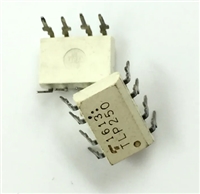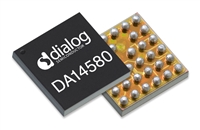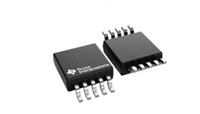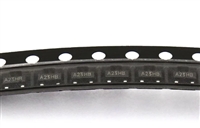AD594/AD595
of R3 should be approximately 280 kΩ. The final connection
diagram is shown in Figure 7. An approximate verification of
the effectiveness of recalibration is to measure the differential
gain to the output. For type E it should be 164.2.
THERMAL ENVIRONMENT EFFECTS
The inherent low power dissipation of the AD594/AD595 and
the low thermal resistance of the package make self-heating
errors almost negligible. For example, in still air the chip to am-
bient thermal resistance is about 80°C/watt (for the D package).
At the nominal dissipation of 800 µW the self-heating in free air
is less than 0.065°C. Submerged in fluorinert liquid (unstirred)
the thermal resistance is about 40°C/watt, resulting in a self-
heating error of about 0.032°C.
+IN
COM
+T
1
4
3
14
–IN
R1
R2
AD594/
AD595
+C
–C
2
6
SETPOINT CONTROLLER
The AD594/AD595 can readily be connected as a setpoint
controller as shown in Figure 9.
9
8
VO
FB
–T
5
LOW = > T < SETPOINT
HIGH = > T > SETPOINT
HEATER
DRIVER
TEMPERATURE
R3
COMPARATOR OUT
CONSTANTAN
SETPOINT
VOLTAGE
HEATER
+5V
(ALUMEL)
Figure 7. Type E Recalibration
INPUT
13
12
11
10
9
8
14
When implementing a similar recalibration procedure for the
AD595 the values for R1, R2, R3 and r will be approximately
650 Ω, 84 kΩ, 93 kΩ and 1.51, respectively. Power consump-
tion will increase by about 50% when using the AD595 with
type E inputs.
OVERLOAD
DETECT
20M⍀
(OPTIONAL)
FOR
AD594/
AD595
+A
HYSTERESIS
ICE
POINT
COMP.
G
G
–TC
+TC
Note that during this procedure it is crucial to maintain the
AD594/AD595 at a stable temperature because it is used as the
temperature reference. Contact with fingers or any tools not at
ambient temperature will quickly produce errors. Radiational
heating from a change in lighting or approach of a soldering iron
must also be guarded against.
IRON
1
2
3
4
5
6
7
(CHROMEL)
TEMPERATURE
CONTROLLED
REGION
COMMON
Figure 9. Setpoint Controller
The thermocouple is used to sense the unknown temperature
and provide a thermal EMF to the input of the AD594/AD595.
The signal is cold junction compensated, amplified to 10 mV/°C
and compared to an external setpoint voltage applied by the
user to the feedback at Pin 8. Table I lists the correspondence
between setpoint voltage and temperature, accounting for the
nonlinearity of the measurement thermocouple. If the setpoint
temperature range is within the operating range (–55°C to
+125°C) of the AD594/AD595, the chip can be used as the
transducer for the circuit by shorting the inputs together and
utilizing the nominal calibration of 10 mV/°C. This is the centi-
grade thermometer configuration as shown in Figure 13.
USING TYPE T THERMOCOUPLES WITH THE AD595
Because of the similarity of thermal EMFs in the 0°C to +50°C
range between type K and type T thermocouples, the AD595
can be directly used with both types of inputs. Within this ambi-
ent temperature range the AD595 should exhibit no more than
an additional 0.2°C output calibration error when used with
type T inputs. The error arises because the ice point compensa-
tor is trimmed to type K characteristics at 25°C. To calculate
the AD595 output values over the recommended –200°C to
+350°C range for type T thermocouples, simply use the ANSI
thermocouple voltages referred to 0°C and the output equation
given on page 2 for the AD595. Because of the relatively large
nonlinearities associated with type T thermocouples the output
will deviate widely from the nominal 10 mV/°C. However, cold
junction compensation over the rated 0°C to +50°C ambient
will remain accurate.
In operation if the setpoint voltage is above the voltage corre-
sponding to the temperature being measured the output swings
low to approximately zero volts. Conversely, when the tempera-
ture rises above the setpoint voltage the output switches to
the positive limit of about 4 volts with a +5 V supply. Figure
9 shows the setpoint comparator configuration complete with a
heater element driver circuit being controlled by the AD594/
AD595 toggled output. Hysteresis can be introduced by inject-
ing a current into the positive input of the feedback amplifier
when the output is toggled high. With an AD594 about 200 nA
into the +T terminal provides 1°C of hysteresis. When using a
single 5 V supply with an AD594, a 20 MΩ resistor from VO to
+T will supply the 200 nA of current when the output is forced
high (about 4 V). To widen the hysteresis band decrease the
resistance connected from VO to +T.
STABILITY OVER TEMPERATURE
Each AD594/AD595 is tested for error over temperature with
the measuring thermocouple at 0°C. The combined effects of
cold junction compensation error, amplifier offset drift and gain
error determine the stability of the AD594/AD595 output over
the rated ambient temperature range. Figure 8 shows an AD594/
AD595 drift error envelope. The slope of this figure has units
of °C/°C.
+0.6؇C
0
50؇C
25؇C
–0.6؇C
TEMPERATURE OF AD594C/AD595C
Figure 8. Drift Error vs. Temperature
–6–
REV. C






 TLP250光耦合器:资料手册参数分析
TLP250光耦合器:资料手册参数分析

 DA14580 低功耗蓝牙系统级芯片(SoC):资料手册参数分析
DA14580 低功耗蓝牙系统级芯片(SoC):资料手册参数分析

 INA226 高精度电流和功率监控器:资料手册参数分析
INA226 高精度电流和功率监控器:资料手册参数分析

 SI2302 N沟道MOSFET:资料手册参数分析
SI2302 N沟道MOSFET:资料手册参数分析
